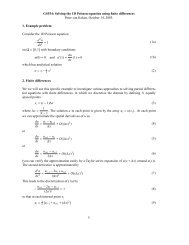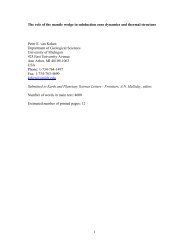Quantitative paleoenvironmental and paleoclimatic reconstruction ...
Quantitative paleoenvironmental and paleoclimatic reconstruction ...
Quantitative paleoenvironmental and paleoclimatic reconstruction ...
Create successful ePaper yourself
Turn your PDF publications into a flip-book with our unique Google optimized e-Paper software.
ARTICLE IN PRESS<br />
N.D. Sheldon, N.J. Tabor / Earth-Science Reviews xxx (2009) xxx–xxx<br />
31<br />
are also rare. However, paleosol calcite δ 13 C values from Upper Permian<br />
<strong>and</strong> Lower Triassic strata of the Karoo Supergroup are characterized by<br />
drab colors, poor soil structural development, <strong>and</strong> calcite δ 13 C values as<br />
low as − 24‰ (Yemane et al., 1989; Macleod et al., 2000; Retallack et al.,<br />
2003; Smith <strong>and</strong> Botha, 2005; Tabor et al., 2007; Melezhik et al., 2007;<br />
Coney et al., 2007). Although the meaning of the very negative δ 13 C<br />
calcite values in the Karoo basin has been interpreted to represent<br />
different processes (e.g., Oceanic links, marine-derived methane;<br />
Macleod et al., 2000), they may possibly represent crystallization in<br />
the presence of one soil CO 2 component (Tabor et al., 2007).<br />
7.4.2. δ 13 C of pedogenic siderite<br />
Pedogenic sphaerosiderite is characterized by a large range of δ 13 C<br />
values, from ~+8‰ to − 45‰, <strong>and</strong> intraprofile sphaerosiderite δ 13 C<br />
values preserve a range of δ 13 C values that vary by as much as 30‰. As<br />
mentioned above, formation of sphaerosiderite in soils is associated<br />
with saturated, anoxic soil profiles that are conducive to methanogenic<br />
bacteria (Faure et al., 1995; Ludvigson et al., 1998; White et al., 2001).<br />
Kinetic carbon isotope fractioantion between CO 2 <strong>and</strong> CH 4 that is<br />
generated by methanogenesis (10 3 ln 13 αCO 2 –CH 4 )rangesfrom~40‰ to<br />
60‰, <strong>and</strong> may produce CO 2 with δ 13 C values as positive as 7‰ (Whiticar<br />
et al.,1986; Faure et al.,1995). Therefore, sphaerosiderites with the most<br />
positive δ 13 C values (N−5‰; Irwin et al., 1977) may represent CO 2 that<br />
was generated directly from methanogenesis, whereas more negative<br />
δ 13 C values may result from (1) closed-system, one-component CO 2<br />
mixing as described above (see Section 7.2.1) <strong>and</strong>/or (2) possible<br />
additional contributions of CO 2 derived from oxidation of methanogenic<br />
CH 4 (Irwin et al.,1977; Faure et al.,1995; Ludvigson et al.,1998). Because<br />
of its complex behaviour, no significant contributions to paleoclimate<br />
<strong>reconstruction</strong> have been made from sphaerosiderite δ 13 Cvalues.<br />
7.4.3. Calcite derived from 2-component soil CO 2 mixing<br />
Two-component models assume that the only sources contributing<br />
to soil CO 2 are CO 2 from the troposphere <strong>and</strong> CO 2 derived from in<br />
situ oxidation of biological carbon in the soil. Under steady-state<br />
conditions of Fickian diffusion, calcite δ 13 C values are expected to<br />
exhibit progressively more positive values upward through the soil or<br />
paleosol profile (see discussion of 2-component soil CO 2 mixing in<br />
Section 7.2.2). The vast majority of studies of soil <strong>and</strong> paleosol calcite<br />
carbon isotopes have sought to interpret δ 13 C values within the<br />
context of a 2-component soil CO 2 mixing model. This reflects, in large<br />
part, that 2-component soil calcite δ 13 C values may permit estimation<br />
of paleoatmospheric pCO 2 .<br />
Two-component soil CO 2 mixing requires free drainage for<br />
oxidation of organic matter <strong>and</strong> open-system exchange with the<br />
global troposphere. As a result, paleosol calcite samples associated<br />
with profiles that lack gley colors, redoximorphic accumulations such<br />
as hematite or manganese nodules, <strong>and</strong> that exhibit well-developed<br />
soil structure are generally regarded as appropriate paleosols for<br />
estimation of paleoatmospheric pCO 2 from calcite δ 13 C values (Ekart<br />
et al., 1999). Furthermore, paleosol matrix should be non-calcareous<br />
in order to avoid possible inheritance of detrital carbonate δ 13 C values,<br />
<strong>and</strong> carbonate texture <strong>and</strong> mineralogy other than microcrystalline<br />
calcite (micrite) should be avoided, as they are possibly diagenetic<br />
alteration products not reflective of conditions during soil formation.<br />
Any inferences about paleoatmospheric pCO 2 values from inappropriate<br />
samples should be disregarded.<br />
7.4.3.1. Estimates of paleoatmospheric pCO 2 . The δ 13 C values of<br />
pedogenic calcite <strong>and</strong> coexisting organic matter may be used to<br />
estimate atmospheric pCO 2 via the following two-component CO 2<br />
mixing equation (Yapp <strong>and</strong> Poths, 1996):<br />
<br />
<br />
δ 13 C mðccÞ = δ 13 C AðccÞ − δ 13 C OðccÞ ðC A =C S Þ cc<br />
+ δ 13 C OðccÞ ð52Þ<br />
Other equations for the solution of paleoatmospheric pCO 2 from<br />
pedogenic mineral δ 13 C values have been presented (Cerling, 1991,<br />
1999; Mora et al., 1996; Ekart et al., 1999; Montañez et al., 2007), but<br />
they all consider the same variables, <strong>and</strong> result in similar pCO 2<br />
estimates. δ 13 C mðccÞ is the measured δ 13 C value of pedogenic calcite.<br />
The δ 13 C values subscripted with “A” <strong>and</strong> “O” are the δ 13 C values of<br />
calcite formed solely in equilibrium with CO 2 derived from the<br />
atmosphere <strong>and</strong> from oxidation of soil organic matter, respectively.<br />
The subscript “(cc)” indicates calcite. C A refers to the concentration of<br />
CO 2 gas in the soil if the only contribution to soil CO 2 were from the<br />
atmosphere. C S is the actual concentration of CO 2 that was present in<br />
the soil. The value for (δ 13 C AðccÞ −δ 13 C OðccÞ ) is assumed to be +16‰<br />
(Yapp <strong>and</strong> Poths, 1991, 1992, 1993, 1996), because it represents the<br />
approximate difference between the estimated δ 13 C values of preindustrial<br />
atmospheric CO 2 (− 6.5‰) <strong>and</strong> recent C 3 continental biota<br />
(−27‰), after the latter value is adjusted for the diffusive 4.4‰<br />
enrichment in δ 13 C in the biologically-derived CO 2 of the soil (Cerling<br />
et al., 1991). Note that other (δ 13 C AðccÞ −δ 13 C OðccÞ ) values have been<br />
suggested (e.g., ~13.7‰, Arens et al., 2000), but differences in this<br />
quantity result in relatively minor differences in estimated pCO 2<br />
values (Yapp <strong>and</strong> Poths, 1991; Tabor et al., 2004a,b).<br />
δ 13 C O(cc) values may be estimated from measured δ 13 C values of<br />
co-existing organic matter within the paleosol profiles (Tabor et al.,<br />
2004a,b; Montañez et al., 2007). δ 13 C O(cc) values should be at least<br />
14.8‰ heavier than the δ 13 C value of oxidizing organic matter in opensystem<br />
soils characterized by mixing of two components of CO 2 (Tabor<br />
et al., 2007). This reflects the diffusive 4.4‰ enrichment in δ 13 C in the<br />
biologically-derived CO 2 (Cerling et al., 1991), as well as an additional<br />
10.4‰ carbon isotope enrichment from gaseous CO 2 to calcite due to<br />
carbon isotope fractionation between carbonate species (at mildly<br />
alkaline pH; Bottinga, 1968). However, Bowen <strong>and</strong> Beerling (2004)<br />
suggest that δ 13 C values of organic matter remaining in paleosol<br />
profiles may result in an overestimate of respired soil CO 2 δ 13 C (<strong>and</strong><br />
δ 13 C O(cc) ), <strong>and</strong> a significant underestimate of atmospheric pCO 2 .If<br />
Bowen <strong>and</strong> Beerling (2004) are correct, then use of fossil organic<br />
matter δ 13 C values for δ 13 C O(cc) provides minimum estimates of<br />
atmospheric pCO 2 rather than absolute estimates.<br />
Because the activity of CO 2− 3 in calcite is fixed at unity, pedogenic<br />
calcite does not, by itself, contain a proxy record of the partial pressure<br />
of soil CO 2 (however, pedogenic goethite does, see Section 7.4.3.3).<br />
Therefore, at this time, the concentration of soil CO 2 (C S ) must be<br />
assumed in order to estimate paleoatmospheric pCO 2 values from<br />
paleosol calcite. These assumptions are constrained by available in situ<br />
measurements of soil CO 2 in modern calcite-producing soils.<br />
The concentration of soil CO 2 is a function of soil depth, soil<br />
respiration rate (or biological productivity), <strong>and</strong> diffusivity of the soil<br />
medium (Boynton <strong>and</strong> Reuther, 1938; Boynton <strong>and</strong> Compton, 1944;<br />
Wood <strong>and</strong> Petraitis, 1984; Quade et al., 1989; Soloman <strong>and</strong> Cerling,<br />
1987). Soil CO 2 concentrations vary from near atmospheric pCO 2<br />
concentrations (a modern value of ~350 ppmV; Keeling et al., 1995)at<br />
the interface with the overlying troposphere to higher, nearly<br />
constant, values beneath a characteristic production (z) depth in the<br />
soil. The location of the characteristic production depth in the soil is<br />
determined by soil respiration rate (or soil productivity) <strong>and</strong> the<br />
diffusivity of the soil medium. Soil diffusivities typically range from 2%<br />
to 50% of that for free air (Glinski <strong>and</strong> Stepniewski, 1985). In general,<br />
more moist <strong>and</strong> clay-rich soils have lower diffusivities, whereas drier<br />
<strong>and</strong> s<strong>and</strong>ier soils have higher diffusivities (Rolston, 1986).<br />
Soil respiration rates, which represent production of CO 2 from<br />
oxidation of organic matter in the soil, appear to (1) primarily reflect a<br />
logarithmic correlation with ambient atmospheric <strong>and</strong> soil temperatures<br />
up to at least 32 °C (Anderson, 1973; Knapp et al., 1998; Fang<br />
et al., 1998; Fang <strong>and</strong> Moncrief, 2001), <strong>and</strong> (2) secondarily respond to<br />
soil moisture availability, although this appears to only be applicable<br />
when soil biota are at or near drought conditions (Brook et al., 1983).<br />
Therefore, characteristic production depths for highly productive soils<br />
Please cite this article as: Sheldon, N.D., Tabor, N.J., <strong>Quantitative</strong> <strong>paleoenvironmental</strong> <strong>and</strong> <strong>paleoclimatic</strong> <strong>reconstruction</strong> using paleosols, Earth-<br />
Science Reviews (2009), doi:10.1016/j.earscirev.2009.03.004















